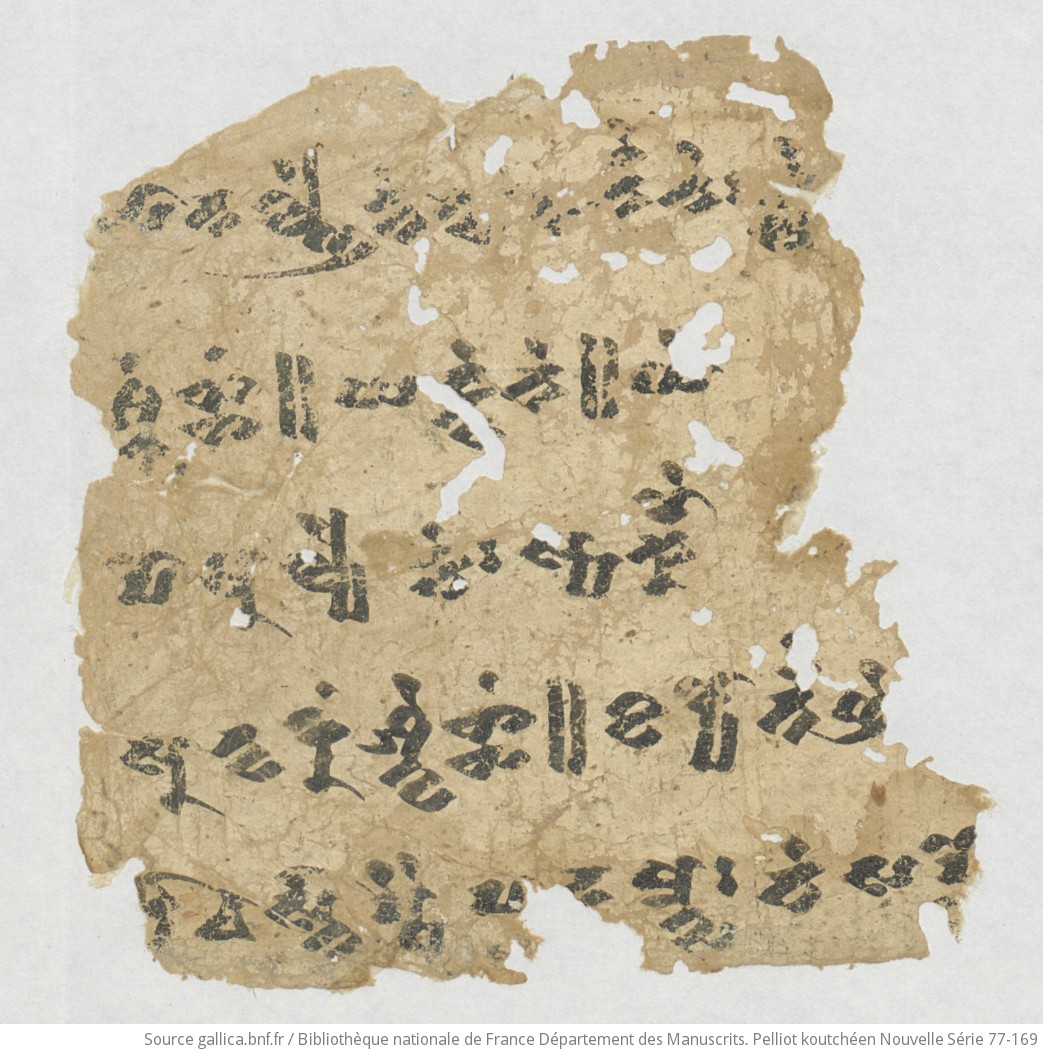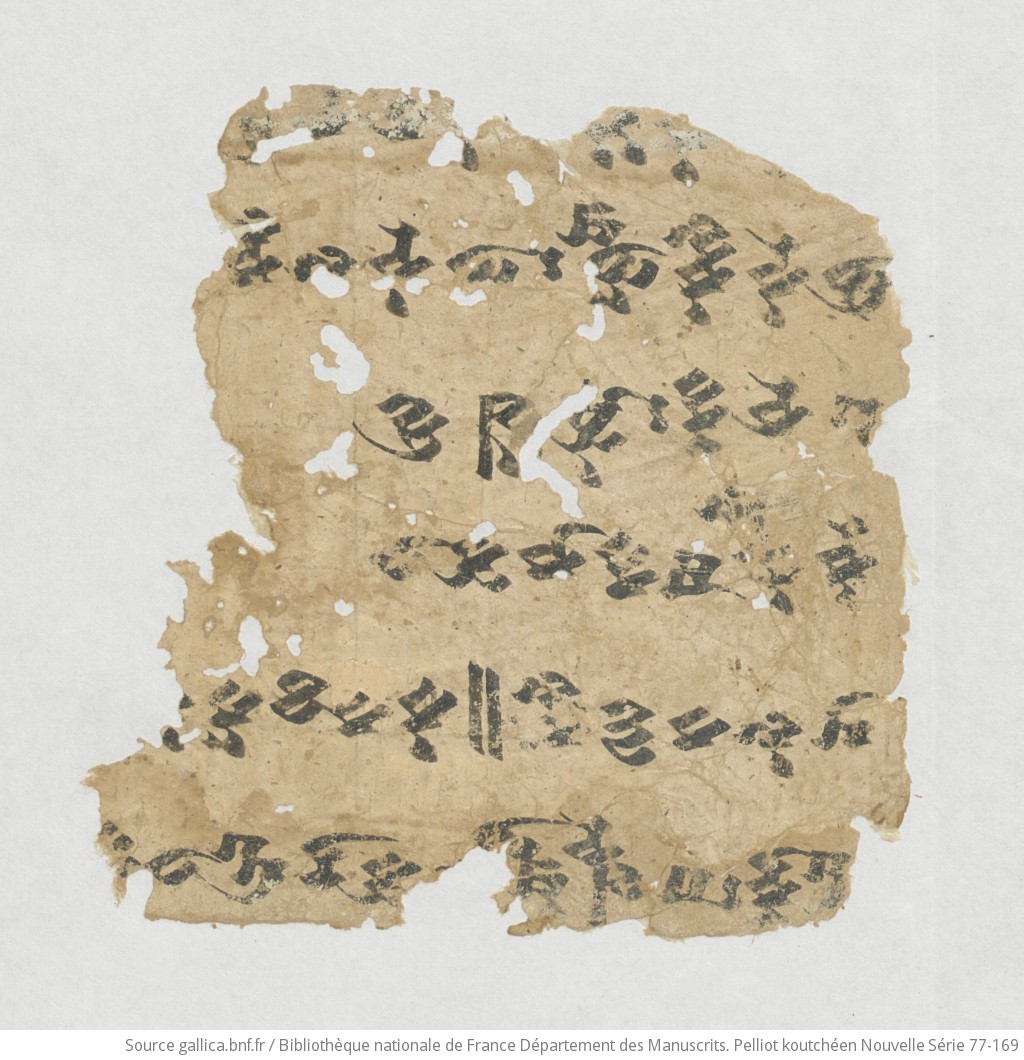| a1 | /// – – [k](·) – [pa] – (·)k(·) [v](·) [c](·) (·)[y](·) (·)[s](·) ś(·) l(·) [ṣ]ṣ(·) la(·) [l](·) nt(·) – [a] [ñ]m(·)(·) ts(·) – (·)sk(·) [ku]l(·) – – – – – (·)ū [ka] [k](·) – ra – (–) |
|---|
| a2 | [y]ā ta lñe ntaṃ¯ ¯ts [pe] rne ne [:] ·le (–) plo nto tra skwa nuṃ tai sa dā ma t[yi] [ña] kti ra 1 || su pri yeṃ lkā ske ma ne pri ye ntse ṣe¯ ¯r pri ya ra ti ñe¯ ¯[m] so mya ra tiṃ |
|---|
| a3 | śwe s̝s̝aṃ || ya kwe ne || ye ○ twe po cme ltse pa lka sne nai ta ṅwaṃ ñ[ai] : ṣe ske wā ks̝ta rse śi ri nne ra meṃ ñä kte : ya kne [p]i (·)[ā] rsa ṣe ṣṣī rku |
|---|
| a4 | po a lye [ṅ]kaṃ : spa rkau ○ sa ka mpa [a] kā lka ntse kne lñe sa : 1 || ta ne su ma na tse ññai u ppā ltsa su pri yeṃ s̝a r[p]s[e] [m]· n[e] pri ya |
|---|
| a5 | su nda riṃ śwe s̝s̝aṃ || ka ryo rtaṃ ñe n(·) || [pa] lsko plu ṣa¯ ¯ñcä nai ka tkau ñai sa śu ke tstse : nau mye śau mo ṣṣe ñśa meṃ pā k[r]i ta tā kau (–) [k](·) cc·[¯] [¯t] so ya stte |
|---|
| a6 | c(·)ī e rsnā ṣṣai pa [d](·) mtsa : ce sa plo nto ta¯ ¯r śi li mu k[r]a p[y]ā pyaiṃ n(·) (–) [w](·) rt(·)o ysāṃ ññe ra cä ñca rñe sa se pa lkaṃ : la laṃ (– – –) (·)o ·e [ṣ]·āṃ py[ā] pyai ṣe |
|---|
| b1 | [ṣ]ṣ(·) rku : pa lka mñe (–) no u ppā la nta yu ko [ṣ](·) : kus(·) no su tā ko¯ ¯yä ce lkā lñe sa so yi nta [:] 2 || tu meṃ pri y· su nda ri (– – – – – –) śwe s̝s̝aṃ || |
|---|
| b2 | pra se na ji ttsa || te na¯ ¯k teṃ [st]e ta [ṅ]wa ña kuce ·w[e] wñā sta ṣa¯ ¯ñä yke ne : sa kwa kī ce ta nma s̝s̝a¯ ¯ñ[ä] yä kne s[o](·) ta(·) y· kn(·) nts(·) [:] [ma] kte sa¯ – ste śu |
|---|
| b3 | ke [ts]tse ma nta kra no la ○ kle nta : e p[yā] cñe sa snai ka rstau mā twa rṣṣī ta¯ ¯rñä pa lsko rmeṃ : klye nta¯ ¯rñä yne śka ṣe ka ññ[e] – ñī ya kni |
|---|
| b4 | pi kā rnta : śau l[ai] wī ○ ta¯ ¯rñ[ä] ce¯ ¯u pre ke sru ka lñe śka¯ ¯s̝ ñyā¯ ¯s rma mñe : ce yā ta lñe¯ ¯ś na mtsa te¯ ¯ñä [m]ā s̝pa śau¯ ¯l la¯ ¯cä |
|---|
| b5 | ñī ke ktse ñmeṃ : ña ke sa ksa pl(·) nto ma¯ ¯r ta rka¯ ¯r yai nm[u] ṣ[p]a rā yra 1 || ta ne su pri ye pa lska lñe ne mai yyā cce yai pu (–) ña ñma mpa ka |
|---|
| b6 | (– –) [ṃ] [k](·) (·)e [s]ai (–) (·)(·)e tā ka [r]ī (–) [ñ]ī ś[a] m(·)a [p]a rna [m]ā lna s[k]e[ṃ] [sa] s[weṃ] tsa wa t[k]ai pr(·) k[s]eṃ ta¯ ¯r ts(·)o riṃ tsa ka pe rke nta rme – [t](·)e [ñ]ā s(·)o[¯] [¯ñc] ñī śa [m](·)a – |
|---|
| a1 | ... the sufferings of life ... of oneself ... |
|---|
| a2 | in the glory of the abilities together with the (wonder) provided with happiness they rejoice like the Sadāmatta gods. 1. |
|---|
| a2+ | Looking at Supriya, the sister of Priya, called Priyaratī, says to Somyaratī: |
|---|
| a3 | in [the tune] yakwe: “Look now at this one, the ornament of every birth, oh loveable one! This one distinguishes himself like the moon among the stars. |
|---|
| a3+ | By [his] manner [and] gesture having surpassed all the others. |
|---|
| a4 | He [= Supriya] has gone away with the happiness because of the realisation of [his] wish.” [1d] |
|---|
| a4+ | Here Sumanā pointing at Supriya with a blue lotus says to Priyasundarī: |
|---|
| a5 | in [the tune] käryorttaññe. "Your mind, full of nectar, floats out of joy! The jewel of a human has manifested himself far from me. |
|---|
| a5+ | You rejoice [and] you are satiated about that because of the blue lotus of his beauty. |
|---|
| a6 | He is glad of it [= the beauty] like the bee [Skt. śilīmukha-] among the flowers. 1. Like a golden forest this one gleams out of grace, having surpassed all the deli(cate) (v)eṣ(ṭ)aṇā flowers, through [his] brilliance [which has] outshone [even] the lotuses. |
|---|
| b1 | Who could then exist [who] would [ever] be satiated by this view? 2. Then Priyasundarī ... says to (Sumanā): |
|---|
| b1+ | in [the tune] Prasenajit: |
|---|
| b2 | "Oh loveable one, is it really that what you have said in your place? This creates extreme happiness for me through the manners provided with [correct] manner. |
|---|
| b2+ | How is [it that] the happiness [that is] provided with nectar [exists and] just so even the sufferings? |
|---|
| b3 | By incessant memory this [question] is not kept away from my thinking. |
|---|
| b3+ | (All) my manners [of acting and my] gestures stand constantly before my eyes indeed. |
|---|
| b4 | May life turn my desire [and] inclination precisely towards death at that moment! My [desire] has bowed to this ability |
|---|
| b4+ | aand the life will not part from my body! |
|---|
| b5 | Now I rejoice with happiness like a sparrow [that has] reached a cloud. 1. |
|---|
| b5+ | Here Supriya entered in deep reflexion [and] only by himself says: |
|---|
| b6 | "Which has been the refuge and (protecti)on of the city? They [= the people of the city] do not go outside in my presence [and] they neglect [what has been] ordered by the lord; they peer at us only through the gaps [in the windows/doors coverings]. [Are they] really (not) desirous (to come together) with me? |
|---|
Peyrot, Michaël. 2013b. The Tocharian subjunctive. A study in syntax and verbal stem formation. Vol. 8. Brill’s Studies in Indo-European Languages & Linguistics. Leiden/Boston: Brill.




